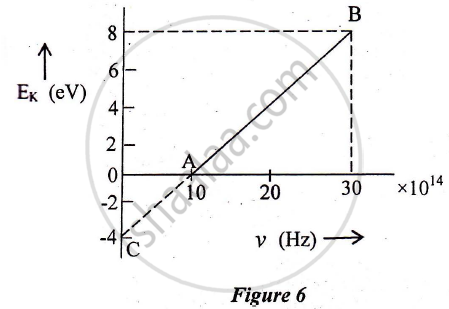Advertisements
Advertisements
प्रश्न
State how will you use this graph to detennine the value of Planck's constant.
उत्तर
From the graph the slope , tan θ = `(V_s)/f`
⇒ tan `theta =h/e [∵V_s =h/ef]`
∴ h = Planck's constant = e tan θ
Thus, knowing the slope we can get the value of 'h' - Planck's constant
APPEARS IN
संबंधित प्रश्न
Sketch the graphs showing variation of stopping potential with frequency of incident radiations for two photosensitive materials A and B having threshold frequencies vA > vB.
(i) In which case is the stopping potential more and why?
(ii) Does the slope of the graph depend on the nature of the material used? Explain.
In an experiment of the photoelectric effect, the graph of maximum kinetic energy EK of the emitted photoelectrons versus the frequency v of the incident light is a straight line AB shown in Figure 6 below:

Find:
1) Threshold frequency of the metal
2) The work function of the metal.
3) Stopping potential for the photoelectrons emitted by the light of frequency `v = 30 xx 10^14 Hz`
Draw a plot showing the variation of photoelectric current with collector potential for different frequencies but same intensity of incident radiation ?
Use Einstein's photoelectric equation to explain the observations from this graph ?
What change will you observe if intensity of incident radiation is changed but the frequency remains the same?
A beam of monochromatic radiation is incident on a photosensitive surface. Answer the following question giving reason :
On what factors does the number of emitted photoelectrons depend?
Calculate the momentum of a photon of energy 6 x I 0-19 J.
With reference to the photoelectric effect, what is meant by threshold wavelength?
Plot a labelled graph of IVsl where Vs is stopping potential versus frequency f of the incident radiation.
Consider an electron in front of metallic surface at a distance d (treated as an infinite plane surface). Assume the force of attraction by the plate is given as `1/4 q^2/(4πε_0d^2)`. Calculate work in taking the charge to an infinite distance from the plate. Taking d = 0.1 nm, find the work done in electron volts. [Such a force law is not valid for d < 0.1nm].
